ignition Oldsmobile Aurora 1997 s Owner's Guide
[x] Cancel search | Manufacturer: OLDSMOBILE, Model Year: 1997, Model line: Aurora, Model: Oldsmobile Aurora 1997Pages: 404, PDF Size: 20.75 MB
Page 85 of 404
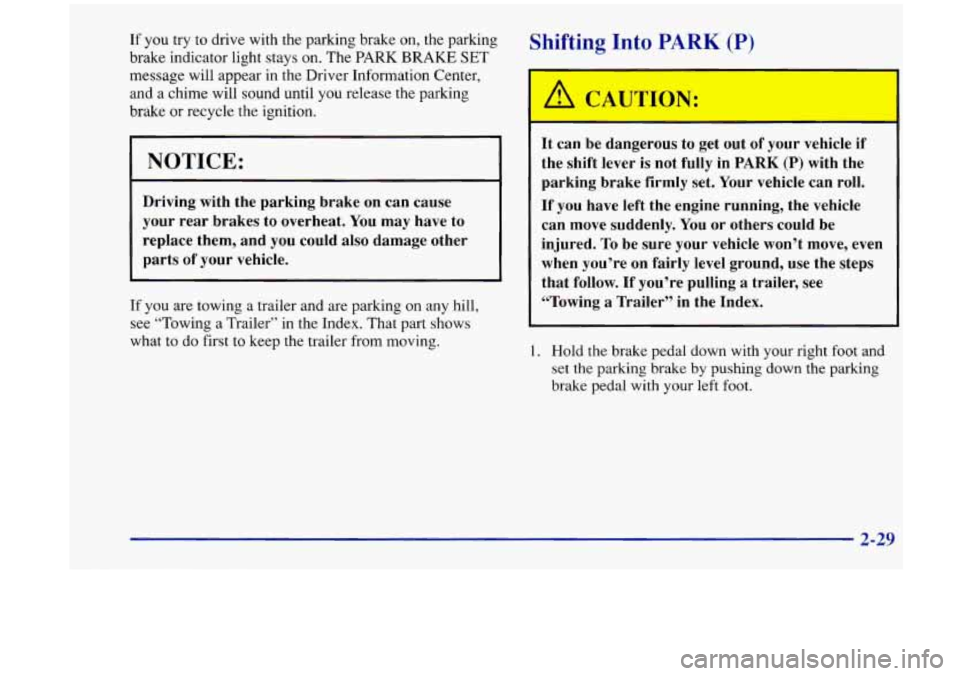
If you try to drive with the parking brake on, the parkin
brake indicator light stays
on. The PARK BRAKE SET
message will appear in the Driver Information Center,
and a chime will sound until you release the parking
brake or recycle the ignition.
NOTICE:
Driving with the parking brake on can cause
your rear brakes to overheat.
You may have to
replace them, and you could also damage other
parts of your vehicle.
If you are towing a trailer and are parking on any hill,
see “Towing a Trailer” in the Index. That part shows
what to do first to keep the trailer from moving.
Shifting Into PARK (P)
It can be dangerous to get out of your vehicle if
the shift lever
is not fully in PARK (P) with the
parking brake firmly set. Your vehicle can roll.
If you have left the engine running, the vehicle
can move suddenly.
You or others could be
injured. To be sure your vehicle won’t move, even
when you’re on
fairly level ground, use the steps
that follow.
If you’re pulling a trailer, see
“Towing
a Trailer’’ in the Index.
1. Hold the brake pedal down with your right foot and
set the parking brake by pushing down the parking
brake pedal with your left
foot.
2-29
Page 86 of 404
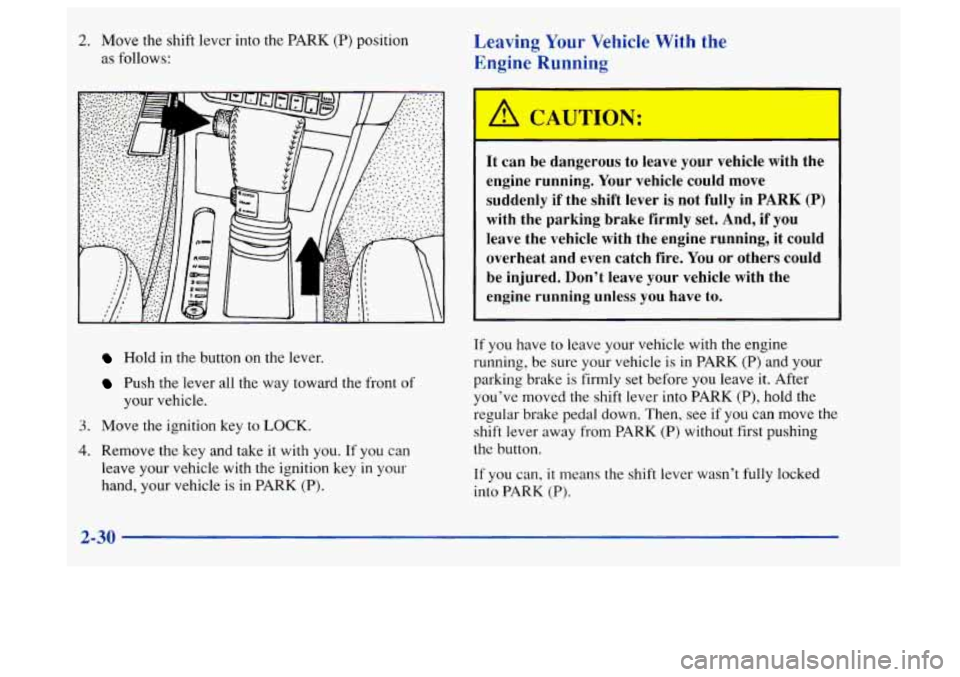
2. Move the shift lever into the PARK (P) position
as
follows:
Leaving Your Vehicle With the
Engine Running
It can be dangerous to leave your vehicle with the
engine running. Your vehicle could move
suddenly if the shift lever is not fully in PARK
(P)
with the parking brake firmly set. And, if you
leave the
ehicle with the engine running, it could
overheat and even catch fire.
You or others could
be injured. Don’t leave your vehicle with the
engine running unless you have to.
Hold in the button on the lever.
Push the lever all the way toward the front of
your vehicle.
3. Move the ignition key to LOCK.
4. Remove the key and take it with you. If you can
leave your vehicle with the ignition key
in your
hand, your vehicle is in PARK
(P).
If you have to leave your vehicle with the engine
running, be sure your vehicle is in PARK (P) and your
parking brake is firmly set before you leave it. After
you’ve moved the shift lever into PARK
(P), hold the
regular brake pedal down. Then, see if you can move the
shift lever away from PARK (P) without first pushing
the button.
If you can,
it means the shift lever wasn’t fully locked
into PARK
(P).
2-30
Page 87 of 404
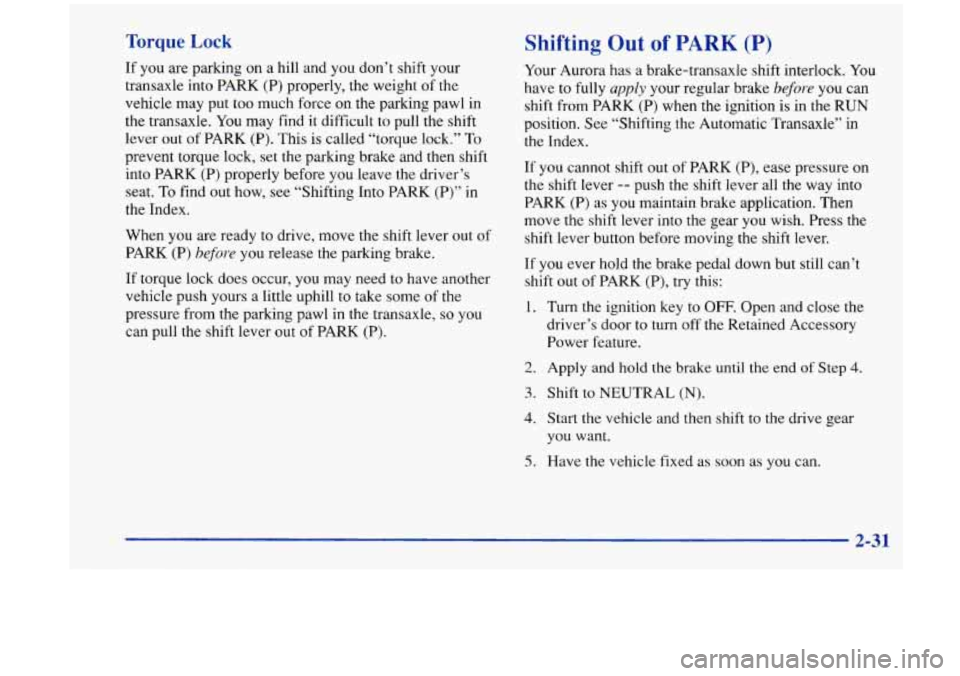
Torque Lock
If you are parking on a hill and you don’t shift your
transaxle into PARK (P) properly, the weight of the
vehicle may put too much force on the parking pawl in
the transaxle. You may find it difficult to pull the shift
lever out of PARK (P). This is called “torque lock.”
To
prevent torque lock, set the parking brake and then shift
into PARK (P) properly before you leave the driver’s
seat. To find out how,
see “Shifting Into PARK (P)” in
the Index.
When you are ready
to drive, move the shift lever out of
PARK (P)
before you release the parking brake.
If torque lock does occur, you may need to have another
vehicle push yours a little uphill to take some
of the
pressure from the parking pawl in the transaxle,
so you
can pull the shift lever out
of PARK (P).
Shifting Out of PARK (P)
Your Aurora has a brake-transaxle shift interlock. You
have
to fully apply your regular brake before you can
shift from PARK (P) when the ignition is
in the RUN
position. See “Shifting the Automatic Transaxle” in
the Index.
If you cannot shift out of PARK (P), ease pressure on
the shift lever
-- push the shift lever all the way into
PARK (P) as you maintain brake application. Then
move the shift lever into the gear you wish. Press the
shift lever button before moving the shift lever.
If you ever hold the brake pedal down but still can’t
shift out
of PARK (P), try this:
1.
2.
3.
4.
5.
Turn the ignition key to OFF. Open and close the
driver’s door to turn off
the Retained Accessory
Power feature.
Apply and hold the brake until
the end of Step 4.
Shift to NEUTRAL (N).
Start the vehicle and then shift to the drive gear
you want.
Have the vehicle fixed as
soon as you can.
2-31
Page 90 of 404
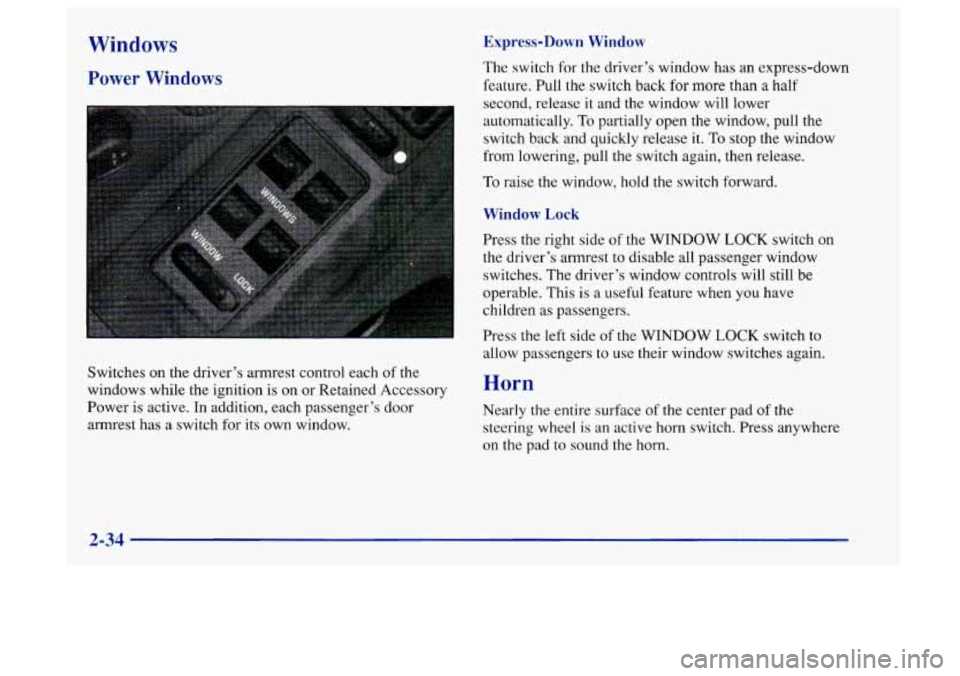
Windows
Power Windows
Switches on the driver’s armrest control each of the
windows while the ignition is on or Retained Accessory
Power is active. In addition, each passenger’s door
armrest has
a switch for its own window.
Express-Down Window
The switch for the driver’s window has an express-down
feature. Pull the switch back
for more than a half
second, release it and the window will lower
automatically.
To partially open the window, pull the
switch back and quickly release it.
To stop the window
from lowering, pull the switch again, then release.
To raise the window, hold the switch forward.
Window Lock
Press the right side of the WINDOW LOCK switch on
the driver’s armrest to disable all passenger window
switches. The driver’s window controls will still be
operable. This is a useful feature when you have
children as passengers.
Press the left side of the WINDOW
LOCK switch to
allow passengers
to use their window switches again.
Horn
Nearly the entire surface of the center pad of the
steering wheel
is an active horn switch. Press anywhere
on the pad to sound the horn.
2-34
Page 93 of 404
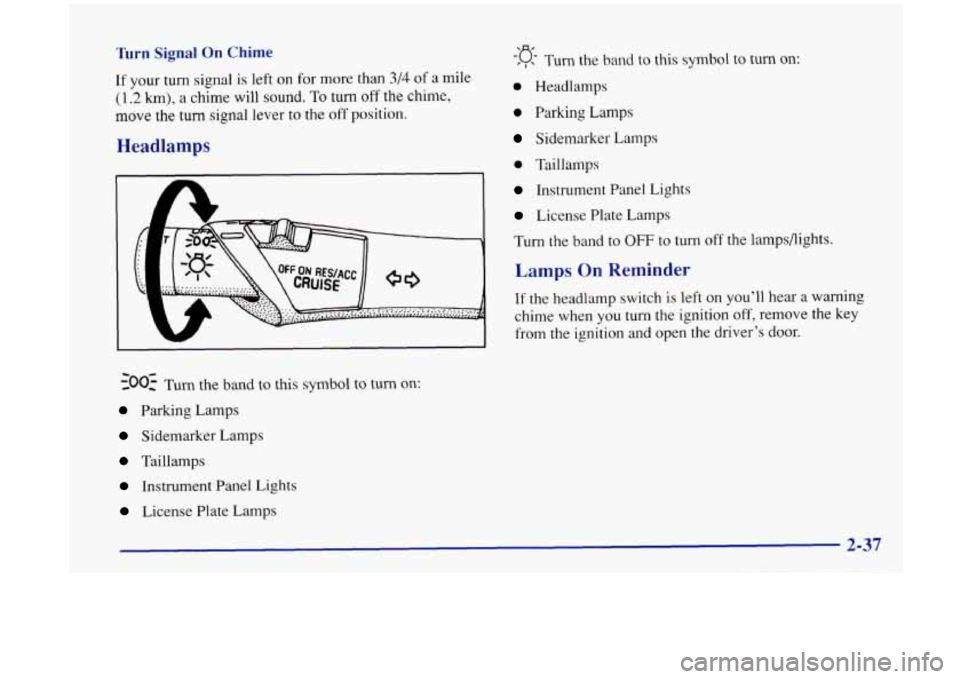
Turn Signal On Chime
If your turn signal is left on for more than 3/4 of a mile
(1.2 km), a chime will sound. To turn off the chime,
move the turn signal lever to the off position.
Headlamps
Turn the band to this symbol to turn on:
Parking Lamps
Sidemarker Lamps
Taillamps
Instrument Panel Lights
License Plate Lamps
-‘Q , , Turn the band to this symbol to turn on:
0 Headlamps
0 Parking Lamps
Sidemarker Lamps
0 Taillamps
Instrument Panel Lights
License Plate Lamps
Turn the band to
OFF to turn off the lampsflights.
Lamps On Reminder
If the headlamp switch is left on you’ll hear a warning
chime when you turn the ignition
off, remove the key
from the ignition and open the driver’s door.
Page 99 of 404
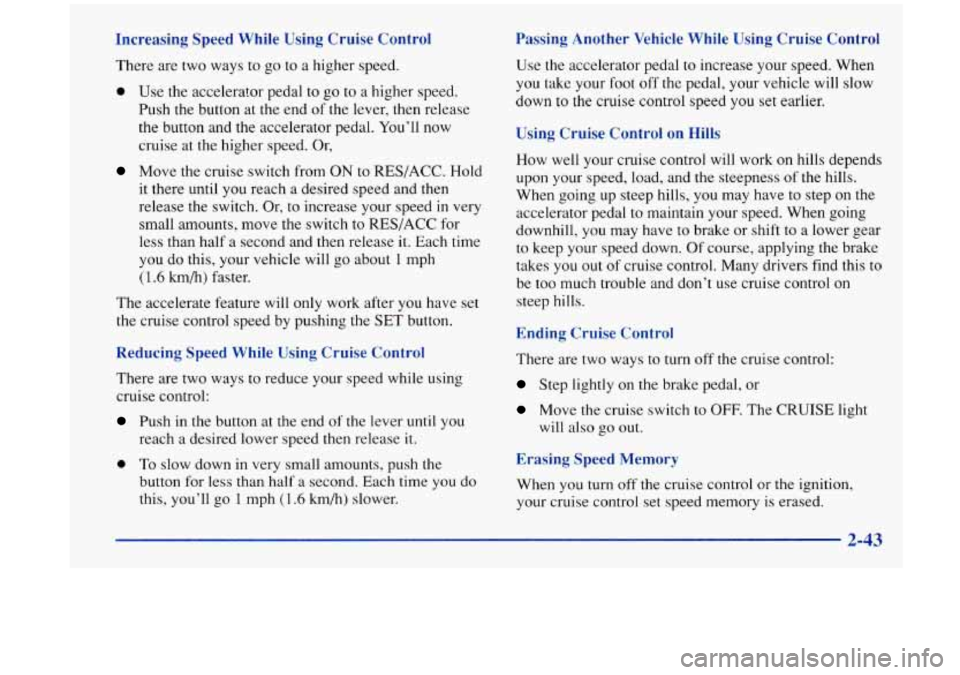
Increasing Speed While Using Cruise Control
There are two ways to go to a higher speed.
0 Use the accelerator pedal to go to a higher speed.
Push the button at the end of the lever, then release
the button and the accelerator pedal. You’ll now
cruise at the higher speed. Or,
Move the cruise switch from ON to RES/ACC. Hold
it there until you reach a desired speed and then
release the switch. Or, to increase your speed in very
small amounts, move the switch to RES/ACC for
less than half a second and then release
it. Each time
you do this, your vehicle will
go about 1 mph
(1.6 km/h) faster.
The accelerate feature will only work after you have set
the cruise control speed by pushing the SET button.
Reducing Speed While Using Cruise Control
There are two ways to reduce your speed while using
cruise control:
Push in the button at the end of the lever until you
reach a desired lower speed then release it.
0 To slow down in very small amounts, push the
button for less than half a second. Each time you do
this, you’ll go 1 mph (1.6 km/h) slower.
Passing Another Vehicle While Using Cruise Control
Use the accelerator pedal to increase your speed. When
you take your foot off the pedal, your vehicle will slow
down to the cruise control speed you set earlier.
Using Cruise Control on Hills
How well your cruise control will work on hills depends
upon your speed, load, and
the steepness of the hills.
When going up steep hills, you may have to step on the
accelerator pedal to maintain your speed. When going
downhill, you may have
to brake or shift to a lower gear
to keep your speed down. Of course, applying the brake
takes you out of cruise control. Many drivers find this to
be too much trouble and don’t use cruise control on
steep hills.
Ending Cruise Control
There are two ways to turn off the cruise control:
Step lightly on the brake pedal, or
Move the cruise switch to OFF. The CRUISE light
will also
go out.
Erasing Speed Memory
When you turn off the cruise control or the ignition,
your cruise control set speed memory is erased.
2-43
Page 100 of 404
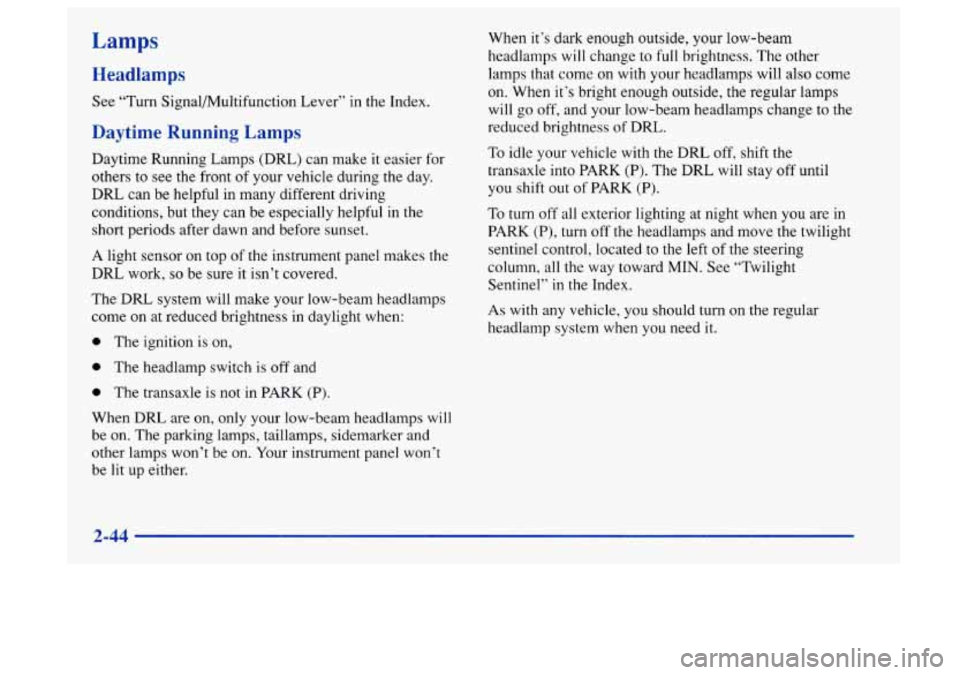
Lamps
Headlamps
See “Turn Signal/Multifunction Lever” in the Index.
Daytime Running Lamps
Daytime Running Lamps (DRL) can make it easier for
others to see the front
of your vehicle during the day.
DRL can be helpful in many different driving
conditions, but they can be especially helpful in the
short periods after dawn and before sunset.
A light sensor on top of the instrument panel makes the
DRL work,
so be sure it isn’t covered.
The DRL system will make your low-beam headlamps
come on at reduced brightness in daylight when:
0 The ignition is on,
0 The headlamp switch is off and
0 The transaxle is not in PARK (P).
When DRL are
on, only your low-beam headlamps will
be on. The parking lamps, taillamps, sidemarker and
other lamps won’t be
on. Your instrument panel won’t
be lit up either. When it’s
dark enough outside, your low-beam
headlamps will change to full brightness. The other
lamps that come on with your headlamps will also come
on. When it’s bright enough outside, the regular lamps
will
go off, and your low-beam headlamps change to the
reduced brightness of DRL.
To idle your vehicle with the DRL off, shift the
transaxle into PARK
(P). The DRL will stay off until
you shift out of PARK
(P).
To turn off all exterior lighting at night when you are in
PARK (P), turn off the headlamps and move the twilight
sentinel control, located to the left
of the steering
column, all
the way toward MIN. See “Twilight
Sentinel” in
the Index.
As with any vehicle, you should turn on the regular
headlamp system when you need
it.
2-44
Page 103 of 404
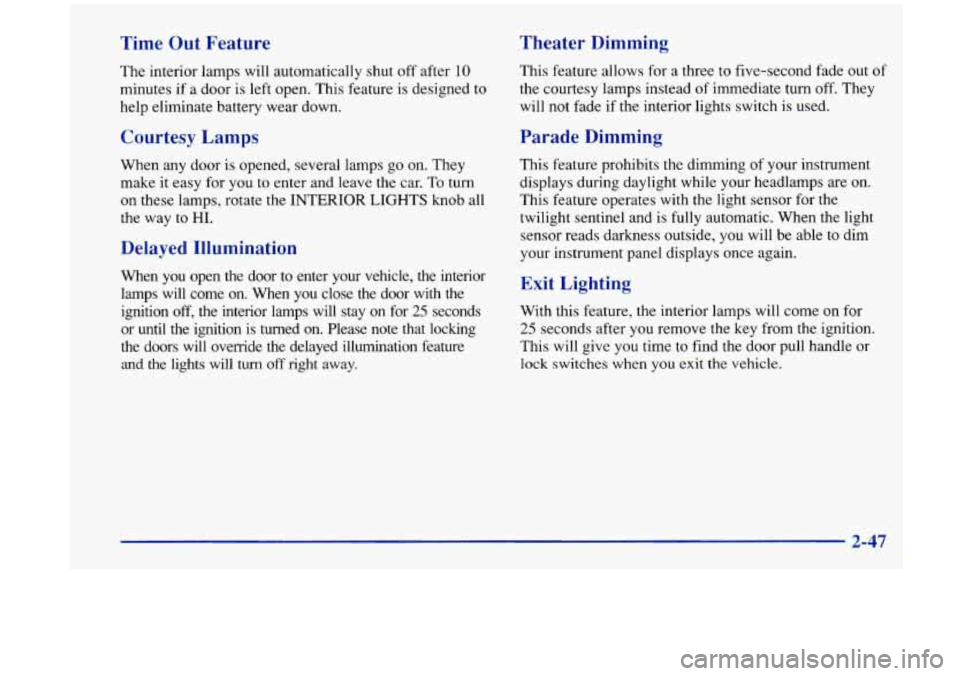
Time Out Feature Theater Dimming
The interior
lamps will automatically shut off after 10
minutes if a door is left open. This feature is designed to
help eliminate battery wear down.
Courtesy Lamps
When any door is opened, several lamps go on. They
make it easy for you to enter and leave the car. To turn
on these lamps, rotate the
INTERIOR LIGHTS knob all
the way to
HI.
Delayed Illumination
When you open the door to enter your vehicle, the interior
lamps will come on. When you close the door with the
ignition
off, the interior lamps will stay on for 25 seconds
or until the ignition is turned on. Please note that locking
the doors will override the delayed illumination feature
and the lights will turn off right away. This feature allows for
a three to five-second fade out
of
the courtesy lamps instead of immediate turn off. They
will not fade if the interior lights switch
is used.
Parade Dimming
This feature prohibits the dimming of your instrument
displays during daylight while your headlamps are on.
This feature operates with the light sensor for
the
twilight sentinel and is fully automatic. When the light
sensor reads darkness outside, you will be able to dim
your instrument panel displays once again.
Exit Lighting
With this feature, the interior lamps will come on for
25 seconds after you remove the key from the ignition.
This will give you time to find the door pull handle or
lock switches when you exit the vehicle.
2-47
Page 104 of 404
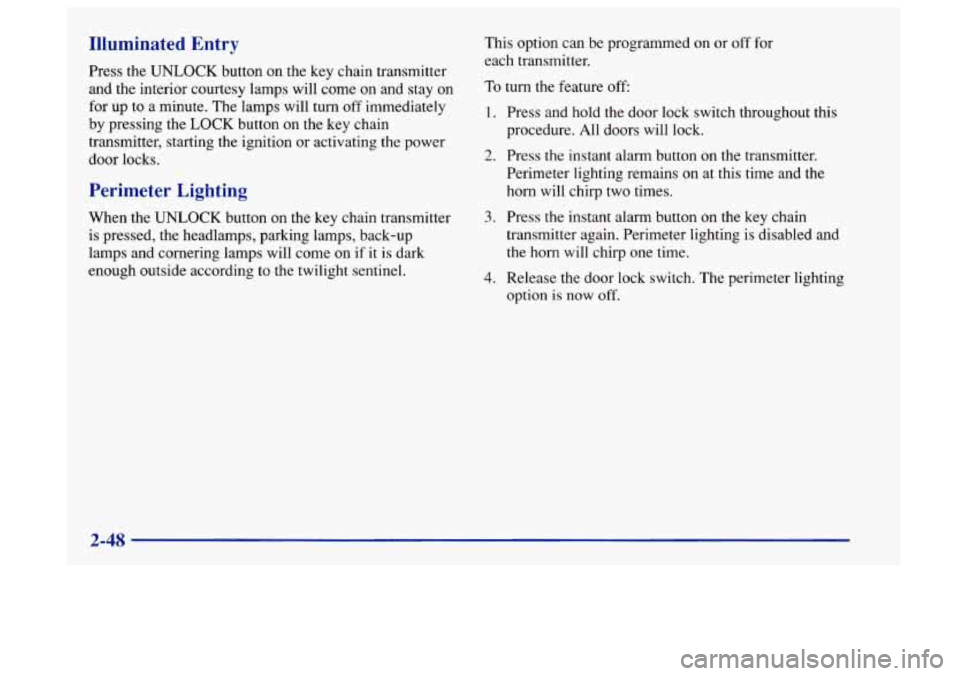
Illuminated Entry
Press the UNLOCK button on the key chain transmitter
and the interior courtesy lamps will come on and stay on
for up
to a minute. The lamps will turn off immediately
by pressing the
LOCK button on the key chain
transmitter, starting the ignition or activating the power
door locks.
Perimeter Lighting
When the UNLOCK button on the key chain transmitter
is pressed, the headlamps, parking lamps, back-up
lamps and cornering lamps will come on if it is dark
enough outside according to the twilight sentinel.
This option can be programmed on or off for
each transmitter.
To turn the feature off
1. Press and hold the door lock switch throughout this
procedure. All doors will lock.
2. Press the instant alarm button on the transmitter.
Perimeter lighting remains on at this time and the
horn will chirp two times.
3. Press the instant alarm button on the key chain
transmitter again. Perimeter lighting is disabled and
the horn will chirp one time.
4. Release the door lock switch. The perimeter lighting
option is now
off.
2-48
Page 105 of 404

To turn the feature on: Front Reading Lamps
1.
2.
3.
4.
Press and hold the door lock switch throughout this
procedure. All doors will lock.
Press the instant alarm button
on the key chain
transmitter. Perimeter lighting remains off at this
time and the
horn will chirp one time.
Press the instant alarm button on the transmitter
again. Perimeter lighting is now enabled and the
horn will chirp two times.
Release the door lock switch. The perimeter lighting
option is now on.
These lamps and the interior courtesy lamps will come
on when you open a door. They will turn off when you
turn on
the ignition. If the door is left open, they will
turn off after about
10 minutes.
To turn
on the reading lamps when the doors are closed,
press the button behind the lamp you want on. Press
it
again to turn the lamp off.
These lamps work even when the ignition is off. To avoid
draining your vehicle's battery, be sure to
turn off all front
and rear reading lamps when leaving your vehicle.
2-49